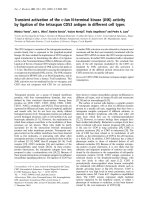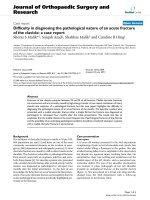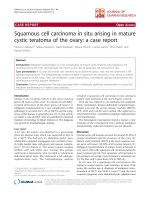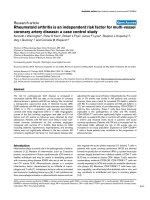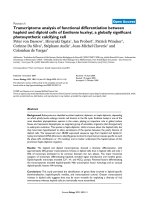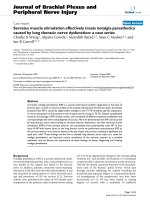Báo cáo y học: " Transient bilateral abducens neuropathy with post-tetanic facilitation and acute hypokalemia associated with oxaliplatin: a case report" pot
Bạn đang xem bản rút gọn của tài liệu. Xem và tải ngay bản đầy đủ của tài liệu tại đây (219.46 KB, 3 trang )
CAS E RE P O R T Open Access
Transient bilateral abducens neuropathy with
post-tetanic facilitation and acute hypokalemia
associated with oxaliplatin: a case report
Min-Han Tan
1,2*
, Wen Yee Chay
1
, Jia Hui Ng
1
, Bin Tean Teh
2
, Lita Chew
3
Abstract
Introduction: Oxaliplatin is a cytotoxic platinum compound that is in widespread use in the treatment of
gastrointestinal cancers. It has been occasionally associated with acute motor neuropathy, but the precise
mechanism is uncertain. To the best of our knowledge, we report the first case of a patient demonstrating post-
tetanic facilitation in the setting of transient bilateral abducens neuropathy and hypokalemia, after being infused
with oxaliplatin.
Case presentation: A 47-year-old Indian woman with metastatic gastric cancer was receiving an oxaliplatin
infusion at the initiation of her third cycle of palliative chemotherapy. She developed acute bilateral abducens
neuropathy with post-tetanic facilitation alongside acute laryngopharyngodysesthesia and hypokalemia. Following
supportive management, including potassium infusion and warming, her neurological signs and symptoms were
spontaneously resolved. This syndrome did not recur in subsequent cycle s following prolongation of infusion
duration and the addition of supportive calcium and magnesium infusions.
Conclusion: The novel clinical observation of post-tetanic facilitation highlights a possible involvement of voltage-
gated channels at the presynaptic terminals in the mechanism of acute oxaliplatin neurotoxicity.
Introduction
Oxaliplatin is a recently developed cytotoxic platinum
compound that is in widespread use, particularly for the
treatment of gastrointestinal cancers [1]. The assoc iation
between oxaliplatin and acute and chronic sensory neuro-
pathy is well recognized, but acute motor neuropathy is
also reported, albeit muc h less frequently [2 ]. The exact
mechanisms of both acute and chronic neurotoxicity
remain uncertain, despite extensive clinical experience
with the compound. It is conventionally regarded that the
voltage-gated sodium channels are involved in mechan-
isms of acute neurotoxicity [3], possibly through a pathway
involving calcium ions [4]. The use of calcium and magne-
sium infusions is currently under investigation [5].
Case presentation
We report a novel observation in a 47-year-old Indian
woman with no comorbidities who developed acute
bilateral abducens neuropathy with post-tetanic facilita-
tion alongside acute hypokalemia after i nfusion of oxali-
platin. She was first diagnosed with peritoneal
carcinomatosis arising from metastatic gastric adenocar-
cinoma, and was commenced on a palliative chemother-
apy regimen of continuous infusion 5-fluorouracil (5-
FU) 200 mg/m
2
/day and weekly oxaliplatin (50 mg abso-
lute dose). After the first cycle totaling 150 mg oxalipla-
tin, during which s ignificant clinical and radiological
improvement in her int estinal function was documented
permitting administration of oral medication, h er regi-
men was modified to a three-weekly regimen of oxali-
platin (130 mg/m
2
on day 1 over 2 hours) and
capecitabine (2000 mg/m
2
/day on day 1 evening - day
15 morning) ( XELOX). One hour into the infusion of
oxaliplatin of the 2nd cycle of XELOX, she developed
acute neuropathy comprising acute bilateral abducens
neuropathy, dysarthria, laryngopharyngodysesthesia,
perioral and peripheral numbness. In addition to oxali-
platin, she had received 8 mg of intravenous dexametha-
sone and 8 mg of intravenous ondansetron as
* Correspondence:
1
Department of Medical Oncology, National Cancer Centre, 11 Hospital
Drive, Singapore 169610, Republic of Singapore
Tan et al. Journal of Medical Case Reports 2010, 4:36
/>JOURNAL OF MEDICAL
CASE REPORTS
© 2010 Tan et al; licensee BioMed Central Ltd. This is an Open Access article distributed under the terms of the Creative Commons
Attribution License ( which permits unrestricted use, distribution, an d reproduction in
any medium, provided the origin al work is properly cited.
premedication. The patient had not taken any oral med-
ications other than capecitabine up to one week pre-
viously. The patient demonstrated physical signs
consistent with bilateral abducens neuropathy, with
bilateral gaze-evoked diplopia. Surprisingly, post-tetanic
facilitation was observed, with unilateral resolution of
diplopia and abducens neuropathy following sustained
lateral gaze over one minute. Contralateral abducens
neuropathy remained unchanged following apparent
resolution of the unilateral abducens neuropathy. The
apparently resolved unilateral abducens neuropathy
recurred following a two-mi nute rest. Decreased tendon
reflexes diffusely were noted, but no focal or generalized
weakness was found. New electrocardiographic changes
in terms of diffuse T-wave inversions were noted, as
well as mild elevation of her serum creatine kinase-MB
(CK-MB) levels by mass assay. Also noted was a serial
decrease over 16 hours (7.0 μg/L immediately, 5.2 μg/L
8hourslaterand3.9μg/L 16 hours later), but the dif-
fuse T-wave inversions persisted. Corresponding serial
serum creatine kinase (CK) levels were 72 μg/L, 63 μg/L
and 52 μg/L, and troponin-T levels were not elevated at
any of these three-time points.
Baseline blood counts and electrolytes drawn two days
prior were unremarkable; in particular, her potassium
levelwas3.5mmolL
-1
(3.3-4.9 mmol L
-1
). She was
asymptomatic up t ill this event. In particular, there was
no intervening symptom of vomiting or diarrhoea, and
the patient did not report the use of any oral medica-
tions. The patient did not have prior hypokalemia up to
this point. Electrolytes drawn immediately upon onset of
neurological symptoms revealed acute hypokalemia, with
a serum potassium level of 2.5 mmo l L
-1
with a normal
serum bicarbonate level of 23.1 mmol L
-1
(19.0-31.0
mmol L
-1
), normal corrected serum total calcium level
of 2.28 (2.10-2.60 mmol L
-1
)andmagnesiumlevelof
0.78 mmol/L (0.70-0.95 mmol L
-1
).
The patient was placed in a warm environment and an
aggressive potassium replacement was undertaken. She
did not receive calcium or magnesium infusions. The
bilateral abducens ne uropathy, dysarthria and laryngo-
pharyngodysesthesia resolved over two hours. The hypo-
kalemia, perioral and peripheral numbness resolved over
twelve hours. Due to the short duration of the episode,
no electromyogram (EMG) or nerve conduction testing
was performed. The diffuse T-wave inversions on ECG
did not resolve and remained six months following this
event.
The patient was re-challenged with the same dose of
oxaliplatin for her fourth cycle, with infusion time
extended from 2 to 6 hours, together with calcium and
magnesium infusions, and did not experience subse-
quent neurotoxicity. She continued t o receive second-
line irinotecan and cisplatin, third-line docetaxel, fourth-
line epirubicin, cisplatin and 5-fluorouracil and fifth line
5-fluorouracil and cetuximab. All treatments were toler-
ated reasonably without further adverse events. The
patient eventually passed away from progressive disease
approximately fifteen months after initial diagnosis
while on best supportive care.
Discussion
While the mechanism of oxaliplatin neurotoxicity
remains uncertain, EMG studies have demonstrated per-
ipheral motor nerve hyperexcitability coinciding with
symptoms o f acute neuropathy, including cold-induced
paresthesias and larygopharyngodysesthesias [6]. It is
conventionally regarded that voltage-gated sodium chan-
nels are involved. Preclinical studies showed that oxali-
platin causes prolonged opening of voltage-gated
sodium channels in sensory nerves w ith a resulting
hyperexcitable state [7]. It has been suggested in precli-
nical studies that oxaliplatin may mediate this channelo-
pathy through the r apid chelation o f unbound calcium
through its oxalate metabolite [4].
A previous ex vivo study inv estigating voltage-gated
potassium channels using blockers such as apamin has
been performed, with no apparent correlation b etween
phenotypes induced by apamin and acute oxaliplatin
neurotoxicity [8]. T he authors, however, argue that a
population of apamin-resistant, calcium-dependent
potassium channels has been identified, and that cal-
cium chelation by oxalate provides a viable mechanism
for this to occur . Indeed, recently reported ex vivo work
suggests that oxaliplatin may interfere with voltage-
gated potassium channels [9,10]. Unexpectedly, one of
these tw o reports did not detect an effect of oxaliplatin
on voltage-gated sodium channels [10].
A single case report previously has reported an asso-
ciation bet ween oxaliplatin and bilateral abducens nerve
palsy in a patient heavily exposed to previous cisplatin
[11], but did not report on the phenomenon of post-
tetanic facilitation or associated hypokalemia. Post-teta-
nic facilitation has not been previously recogn ized, and
may imply the involvement of voltage-gated channels in
the presynaptic terminal, where both potassium and cal-
cium channels are present. Calcium-activated presynap-
tic potassium channels in Xenopus are known to
regulate transmitter release magnitude during single
action potentials by altering the rate of action potential
repolarization, and thus the magnitude of peak calcium
current [12].
The acute hypokalemia we observe has been reported
inaseparatecasereportwhereacomaassociatedwith
hypokalemia and hypocalcemia was reported after infu-
sion of oxaliplatin [13]. The mechanism is uncertain.
Given that our patient presented with hypokalemia but
not hypocalcemia, the data does not support systemic
Tan et al. Journal of Medical Case Reports 2010, 4:36
/>Page 2 of 3
calcium chelation as the primary mechanism of acute
oxaliplatin-induced neurotoxicity, but it is conceivable
that a specific locations along the peripheral nerve may
be more vulnerable to accumulation of oxaliplatin or its
metabolites [1]. For example, platinum has been shown
to accumulate in dorsal root ganglia in rodents adminis-
tered oxaliplatin.
We considered the possibility of the acute hypokale-
mia causing the post-tetanic facilitation t hat we
observed. Acute hypokalemia is associated with axonal
and muscle membrane hyperpolarization [14,15]. It
must be acknowledged t hat although our review of the
literature did not report a previous association between
hypokalemia and post-tetanic facilitation, the mechan-
isms of hypokalemia in inducing weakness are complex
and as-yet poorly understood. Hence, a possible contri-
bution of hypokal emia to post-tetanic facilitation cannot
be definitively excluded. However, recent electrophysio-
logic investigations of patients with acute hypokalemia
highlight its contribution to axonal hyperpolarization,
with a resulting activity-dependent conduction block
worsen ing, rather than improving weakness [14]. Hence,
this data suggests that hypokalemia is not the primary
mechanism for post-tetanic facilitation.
Conclusion
In summary, while the mechanism of acute oxaliplatin-
induced neuropathy remains uncertain, our novel clini-
cal observation of post-tetanic facilitation alongside
acute hypokalemia highlights voltage-gated channels at
the presynaptic ner ve terminal for investigation in the
mechanism of acute oxaliplatin neurotoxicity.
Consent
Written informed consent was obtained from the
patient’ s family for publication of this case report. A
copy of the written consent is available for review by
the Editor-in-Chief of this journal.
Acknowledgements
We would like to thank Dr. Umapathi Thirugnanam and Dr. Kevin Tan of the
Department of Neurology, National Neuroscience Institute for their
discussion and input. We would also like to thank the family of the patient
for consenting to publication. MHT is supported by the Singapore Millenium
Foundation and the National Kidney Foundation.
Author details
1
Department of Medical Oncology, National Cancer Centre, 11 Hospital
Drive, Singapore 169610, Republic of Singapore.
2
NCCS-VARI Laboratory of
Translational Cancer Research, National Cancer Centre, 11 Hospital Drive,
Singapore 169610, Republic of Singapore.
3
Oncology Pharmacy, National
Cancer Centre, 11 Hospital Drive, Singapore 169610, Republic of Singapore.
Authors’ contributions
MHT wrote the manuscript. JHN and LC obtained data and reviewed the
literature. CWY and BTT helped write the manuscript. All authors read and
approved the final manuscript.
Competing interests
The authors declare that they have no competing interests.
Received: 4 November 2009
Accepted: 2 February 2010 Published: 2 February 2010
References
1. Cersosimo RJ: Oxaliplatin-associated neuropathy: a review. Ann
Pharmacother 2005, 39:128-135.
2. Argyriou AA, Polychronopoulos P, Iconomou G, Chroni E, Kalofonos HP: A
review on oxaliplatin-induced peripheral nerve damage. Cancer Treat Rev
2008, 34:368-377.
3. Park SB, Goldstein D, Lin CS, Krishnan AV, Friedlander ML, Kiernan MC:
Acute Abnormalities of Sensory Nerve Function Associated With
Oxaliplatin-Induced Neurotoxicity. J Clin Oncol 2009, 27:1243-1249.
4. Grolleau F, Gamelin L, Boisdron-Celle M, Lapied B, Pelhate M, Gamelin E: A
possible explanation for a neurotoxic effect of the anticancer agent
oxaliplatin on neuronal voltage-gated sodium channels. J Neurophysiol
2001, 85:2293-2297.
5. Gamelin L, Boisdron-Celle M, Morel A, Poirier AL, Berger V, Gamelin E,
Tournigand C, de Gramont A: Oxaliplatin-related neurotoxicity: interest of
calcium-magnesium infusion and no impact on its efficacy. J Clin Oncol
2008, 26:1188-1189.
6. Wilson RH, Lehky T, Thomas RR, Quinn MG, Floeter MK, Grem JL: Acute
oxaliplatin-induced peripheral nerve hyperexcitability. J Clin Oncol 2002,
20:1767-1774.
7. Adelsberger H, Quasthoff S, Grosskreutz J, Lepier A, Eckel F, Lersch C: The
chemotherapeutic oxaliplatin alters voltage-gated Na(+) channel kinetics
on rat sensory neurons. Eur J Pharmacol 2000, 406:25-32.
8. Webster RG, Brain KL, Wilson RH, Grem JL, Vincent A: Oxaliplatin induces
hyperexcitability at motor and autonomic neuromuscular junctions
through effects on voltage-gated sodium channels. Br J Pharmacol 2005,
146:1027-1039.
9. Benoit E, Brienza S, Dubois JM: Oxaliplatin, an anticancer agent that
affects both Na+ and K+ channels in frog peripheral myelinated axons.
Gen Physiol Biophys 2006, 25:263-276.
10. Kagiava A, Tsingotjidou A, Emmanouilides C, Theophilidis G: The effects of
oxaliplatin, an anticancer drug, on potassium channels of the peripheral
myelinated nerve fibres of the adult rat. Neurotoxicology 2008,
29:1100-1106.
11. Winquist E, Vincent M, Stadler W: Acute bilateral abducens paralysis due
to oxaliplatin. J Natl Cancer Inst 2003, 95:488-489.
12. Pattillo JM, Yazejian B, DiGregorio DA, Vergara JL, Grinnell AD, Meriney SD:
Contribution of presynaptic calcium-activated potassium currents to
transmitter release regulation in cultured Xenopus nerve-muscle
synapses. Neuroscience 2001, 102:229-240.
13. Basso M, Cassano A, Modoni A, Spada D, Trigila N, Quirino M, Schinzari G,
Barone C: A reversible coma after oxaliplatin administration suggests a
pathogenetic role of electrolyte imbalance. Eur J Clin Pharmacol 2008,
64:739-741.
14. Krishnan AV, Colebatch JG, Kiernan MC: Hypokalemic weakness in
hyperaldosteronism: activity-dependent conduction block. Neurology
2005, 65:1309-1312.
15. Kuwabara S, Kanai K, Sung JY, Ogawara K, Hattori T, Burke D, Bostock H:
Axonal hyperpolarization associated with acute hypokalemia: multiple
excitability measurements as indicators of the membrane potential of
human axons. Muscle Nerve 2002, 26:283-287.
doi:10.1186/1752-1947-4-36
Cite this article as: Tan et al.: Transient bilateral abducens neuropathy
with post-tetanic facilitation and acute hypokalemia associated with
oxaliplatin: a case report. Journal of Medical Case Reports 2010 4:36.
Tan et al. Journal of Medical Case Reports 2010, 4:36
/>Page 3 of 3
